Keyword research is foundational to SEO success, shaping content strategies and ensuring visibility in search engine results.
Effective keyword research uncovers the search queries your target audience uses, helping to align your content with their needs and search intent.
10 Keyword Research Techniques
This article explores ten essential keyword research techniques, highlighting ways to leverage SE Ranking, an all-in-one SEO tool, for deeper insights and strategic advantage, laying the groundwork for improved SEO results.
1. Exploring Seed Keywords
Identifying Your Core Topics
The journey to SEO success begins with identifying core topics relevant to your business or niche. Initiating a brainstorming phase is crucial for establishing a foundation for your keyword research.
For instance, a local bakery specializing in gluten-free products might list core topics such as “gluten-free bread,” “celiac-friendly pastries,” and “gluten-free baking ingredients.” These topics not only reflect the bakery's primary offerings but also cater to specific queries a health-conscious audience might have.
A tech startup specializing in cybersecurity might concentrate on topics such as “data breach prevention”, “secure password management”, and “enterprise cybersecurity tips”, catering to businesses aiming to safeguard their digital assets.
Start by listing down the primary services, products, or themes your business covers. Consider what your target audience might search for when looking for solutions or information you provide. For the bakery, potential customers might search for “where to buy gluten-free birthday cakes” or “gluten-free bakery near me.” For the cybersecurity firm, queries might include “how to prevent cyber attacks on small businesses” or “best cybersecurity software for startups.”
A list of core topics serves as the seed from which your keyword strategy will grow, aligning your SEO efforts with your business objectives and audience interests. By grounding your strategy in these core topics, you create a strong base to expand upon with more detailed and specific keywords, ensuring your content directly addresses the queries and needs of your target audience.
Utilizing SE Ranking's Keyword Suggestion Tool
After establishing your core topics, the next phase involves expanding them into a detailed set of seed keywords, crucial for a well-rounded SEO strategy.
Tools like SE Ranking's keyword suggestion tool excel in streamlining this task:
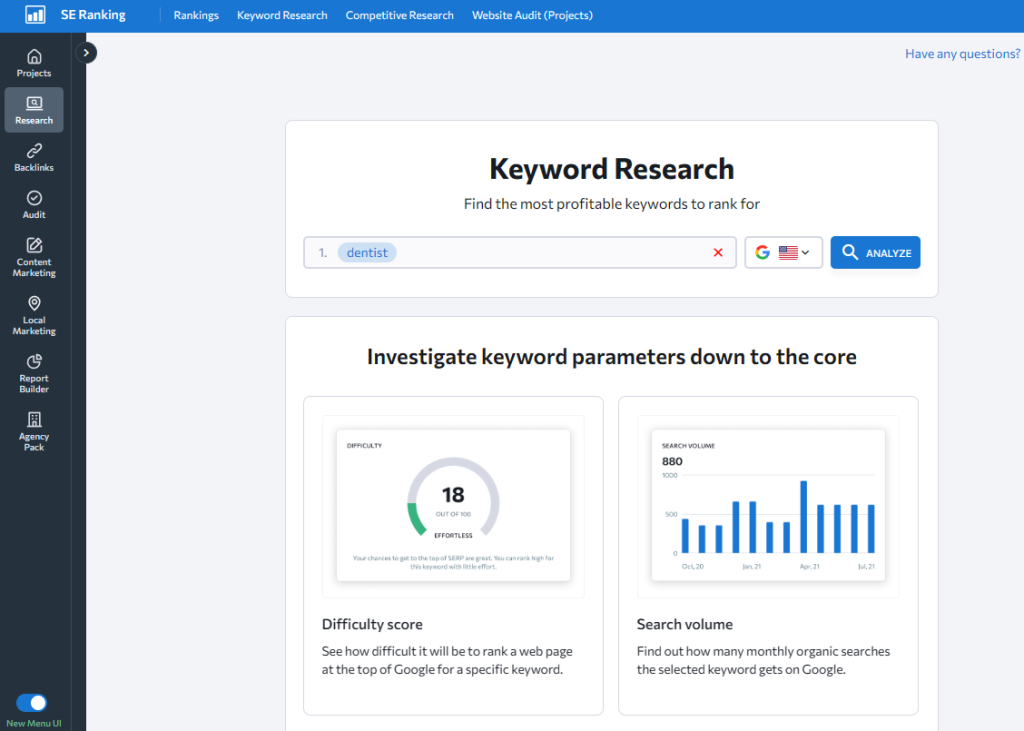
Inputting your core topics into SE Ranking yields an extensive list of related keywords and phrases, including variations and related terms that may not have initially come to mind.
Moreover, SE Ranking offers insights into search volumes, trends, and competitiveness for these suggestions, providing a holistic view of potential keywords.
This comprehensive approach ensures you capture a wide array of relevant queries, laying a solid foundation for a dynamic keyword strategy.
Evaluating Seed Keyword Potential
Evaluating the potential of your seed keywords is a pivotal step that shouldn't be overlooked.
SE Ranking simplifies this process by providing comprehensive metrics for each keyword, such as search volume and competition level.
Here's an example of results for keyword “dentist”:

Search volume gives a glimpse into the keyword's monthly popularity, hinting at its ability to attract traffic. Meanwhile, the competition metric sheds light on the ranking difficulty for each keyword. These insights allow you to weigh the balance between a keyword's traffic potential and the effort required to rank for it effectively.
Leveraging this data, you can smartly prioritize keywords that promise the best mix of high search visibility and lower competition levels. Such a methodical approach ensures your chosen keywords are primed to attract the most relevant visitors to your website, optimizing your SEO strategy for maximum impact and efficiency.
2. Uncovering Long-Tail Keywords
The Value of Long-Tail Keywords
In the competitive online arena, long-tail keywords stand out as a strategic asset for driving targeted traffic. These detailed phrases, which are more specific and less commonly searched, align closely with users' purchase intentions.
Their specificity not only reduces competition but also boosts conversion rates, proving to be a boon for businesses targeting niche markets or tailoring unique content strategies.
In harnessing the power of long-tail keywords, businesses can effectively differentiate themselves in search engine rankings and directly address the specific queries of their audience.
Finding Long-Tail Keywords with SE Ranking
You can use SE Ranking's Keyword Suggestion Tool to quickly find long-tail keywords.
By inputting broad terms relevant to your niche as shown in the image above, the tool generates a list of longer, more specific terms actively used by potential customers.
Here's an example of filtering results for “dentist” to 5-word phrases:
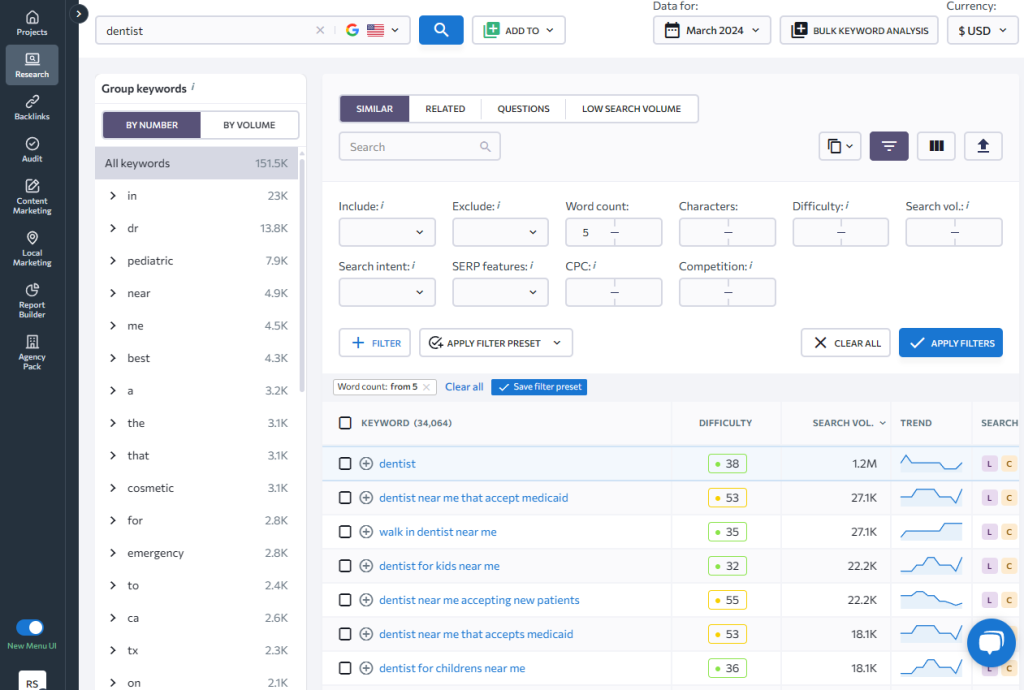
This approach not only uncovers hidden opportunities that are often lower in competition and easier to rank, but also sheds light on the precise language and concerns of your target audience, empowering you to create content that resonates deeply with their needs and interests.
Evaluating the Potential of Long-Tail Keywords
Identifying long-tail keywords is just the beginning; assessing their potential is key to integrating them effectively into your SEO strategy. SE Ranking offers detailed insights into crucial metrics like search volume and keyword difficulty, essential for gauging a keyword's viability.
Contrary to conventional wisdom, a modest search volume for long-tail keywords signals a focused search intent, often leading to better engagement and conversions. Additionally, understanding the difficulty level associated with ranking for these keywords informs you of the necessary effort for successful optimization.
Through evaluating these metrics, you can strategically select long-tail keywords that strike an optimal balance between high search relevance and competitive achievability, steering your content strategy towards impactful outcomes.
3. Conducting Competitor Keyword Analysis
Identifying Your Competitors
The first step in a competitor keyword analysis is to identify who you're up against. This involves pinpointing which websites rank for keywords you're targeting or planning to target.
A straightforward approach is to search for your primary keywords in search engines and note who appears on the first page. These sites are your direct SEO competitors, regardless of whether they're direct business competitors.
Understanding who ranks for your desired keywords offers a starting point for deeper competitive analysis, setting the stage for insightful strategic planning.
Leveraging SE Ranking for Competitor Insights
SE Ranking’s competitor analysis tool reveals the keyword strategies of your rivals.
By inputting a competitor’s domain, you gain access to a comprehensive breakdown of their keyword rankings, including competition, traffic, SERP features, and more.
This visibility into their keyword effectiveness helps you uncover which strategies work in your industry and where there might be weaknesses or gaps in their approach.
Additionally, SE Ranking reveals the search volume, difficulty, and other critical metrics for each keyword, enabling a more nuanced comparison and analysis.

Strategizing Based on Competitor Data
Armed with detailed insights from SE Ranking, you can begin to carve out your competitive edge. Analyze the data to identify keyword gaps—valuable terms your competitors might be overlooking.
Also, look for high-performing keywords where your competitors have lower rankings, indicating opportunities for you to capitalize on.
This information guides your content creation and optimization strategies, allowing you to focus efforts on areas with the highest potential return.
By strategically targeting these keywords, you can enhance your visibility, improve your search rankings, and ultimately, draw more targeted traffic to your site.
4. Understanding Keyword Intent
Types of Keyword Intent
Mastering keyword intent means diving deep into the searcher's mind to understand their goal.
Keywords can be categorized by their intent: informational (seeking knowledge), navigational (looking for a specific website or page), transactional (ready to purchase or perform an action), and commercial (evaluating products or services).
Recognizing the intent behind a search query is critical, as it shapes the content strategy, ensuring you meet users' expectations and guide them smoothly along their journey.
Using SE Ranking to Determine Intent
SE Ranking plays a pivotal role in deciphering the intent behind keywords by analyzing the SERP features triggered by each query.
For instance, a keyword that results in shopping ads or product listings is likely transactional, while one that generates how-to guides or Wikipedia entries is informational.
In this example screenshot, you can see these keywords all have a local intent and a commercial intent, based on the L and C icons under the Search Intent column:
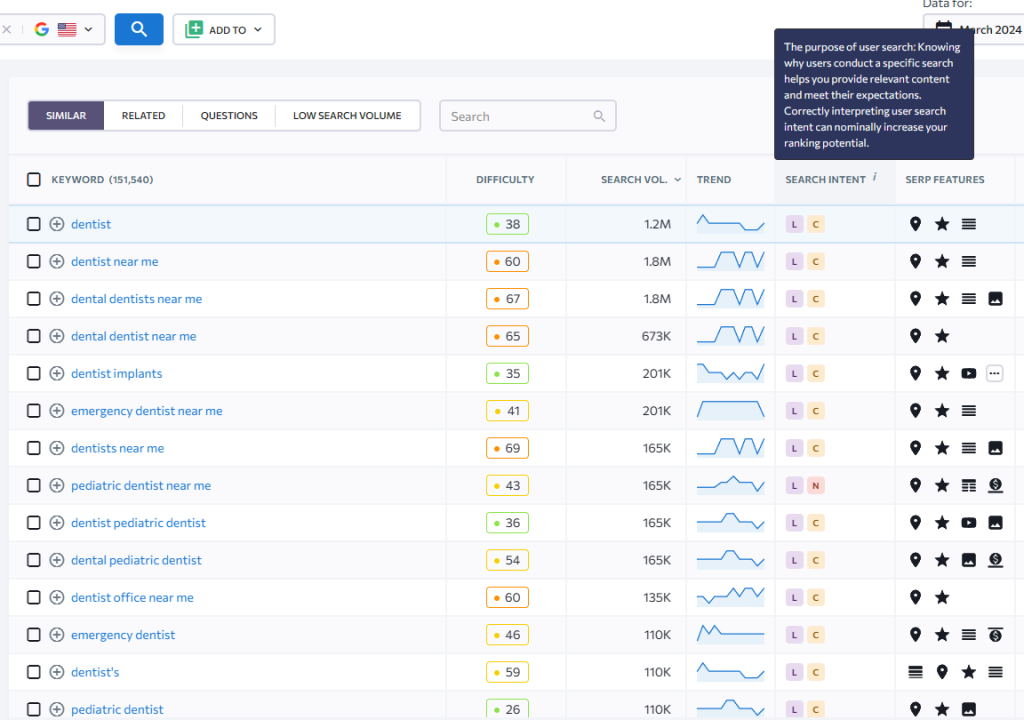
To the right of search intent, you can quickly see features shown in the search results, such as local map results, reviews, images, videos, and the “people also ask” section.
By studying these SERP features, SE Ranking provides valuable clues about the underlying intent, enabling marketers to craft their content with precision, catering specifically to the user's stage in the buying journey.
Matching Content with Intent
Once you've identified the intent, aligning your content with it is crucial. For informational queries, create detailed guides, blog posts, or FAQs.
Navigational intent calls for optimized landing pages that clearly state your brand and offerings. Transactional searches require compelling product pages or service descriptions that encourage action.
Commercial intent is best served by comparison articles, reviews, or case studies that aid in decision-making.
By matching content with keyword intent, you significantly enhance user experience, improve SEO rankings, and increase conversion rates, effectively bridging the gap between user needs and your digital presence.
5. Utilizing Question-Based Keywords
Importance of Question Keywords
Question-based keywords are pivotal for SEO strategies aiming at visibility in featured snippets and optimizing for voice search.
These keywords often start with “who,” “what,” “where,” “when,” “why,” and “how,” mirroring the natural language used in voice queries and the information-seeking behavior of users.
By targeting these queries, content can directly address the user's immediate needs, increasing the chances of appearing at the very top of search results and being chosen for voice-activated searches, thereby boosting traffic and enhancing user engagement.
Finding Questions with SE Ranking
SE Ranking makes the discovery of question-based keywords easy as well. Utilizing the keyword research tool, you can filter down to question type search terms people are asking based on the seed or focus keyword you've entered.
This example shows filtering by question-oriented keywords that are at least 3 words long:

This feature not only aids in content ideation but also helps in understanding the common concerns and information gaps within your audience.
By focusing on these real-world queries, you can tailor your content strategy to directly answer your audience's most pressing questions, positioning your site as a valuable resource.
Incorporating Questions into Your Content
Best practices for incorporating question-based keywords into your content include:
- Directly Answering Questions: Craft content that provides clear, concise, and authoritative answers to the questions you've identified. This approach increases the likelihood of capturing featured snippets.
- Structured Content: Use questions as headings or subheadings to structure your content, making it easier for search engines to understand and index your answers.
- Comprehensive Coverage: Where applicable, expand on your answers by covering related subtopics and questions. This not only adds depth to your content but also caters to a broader range of user queries.
- FAQ Sections: Implementing FAQ sections on your website or within articles can effectively target a multitude of question-based keywords, directly addressing user queries and improving your site's visibility for voice searches.
By strategically using question-based keywords, you enhance your content's relevance to user queries, improving your chances of ranking higher in search results and becoming the go-to source for information in your niche.
6. Analyzing Keyword Difficulty
Understanding Keyword Difficulty
Keyword difficulty is a crucial metric that forecasts the challenges you might face when trying to rank for specific terms. It reflects the competitiveness of a keyword based on the strength of the pages currently ranking on the first search engine results page (SERP).
High difficulty scores indicate that top-ranking spots are occupied by well-established websites with strong SEO profiles, signaling a tougher battle for visibility. Understanding this metric allows you to tailor your SEO strategy, focusing efforts where they're most likely to yield results.
Evaluating Difficulty with SE Ranking
In SE Ranking's keyword suggestion tool, you can filter by keyword difficulty score to save a ton of time figuring out which lower competition keywords to prioritize:
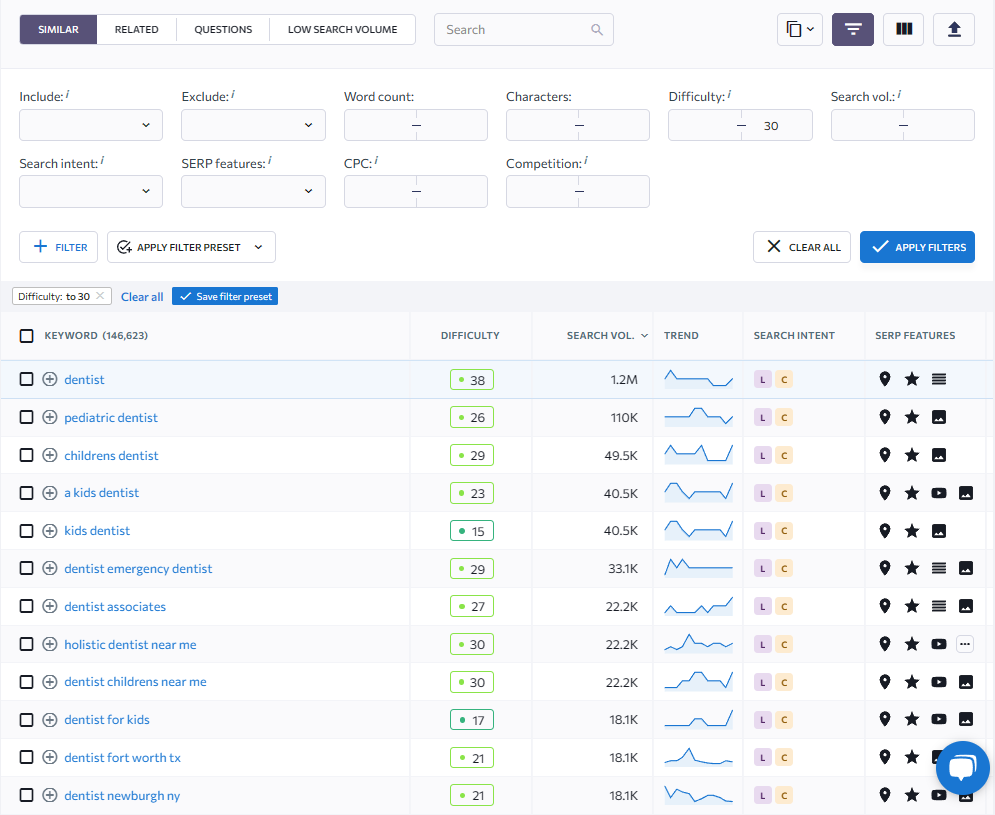
The tool analyzes factors like domain authority, page authority, and backlink profiles of the pages ranking for these keywords, giving you a difficulty score.
This score helps you identify at a glance which keywords are accessible and which may require more robust SEO tactics or a longer timeframe to rank for.
Selecting Keywords Based on Difficulty
Choosing keywords based on difficulty involves a strategic balance.
Aim for a mix of low-difficulty keywords, which can bring quicker wins and traffic boosts, and higher-difficulty keywords, which, despite being more challenging, can significantly increase your site's visibility and authority when conquered.
Consider your current website SEO health and resources available for content creation and link building.
Prioritize low to medium difficulty keywords for short-term goals and reserve high-difficulty keywords for long-term SEO endeavors, ensuring a diversified approach that fosters both immediate growth and sustained success.
7. Tracking Search Volume Trends
The Significance of Search Volume
Search volume is a pivotal metric in keyword research, indicating the average number of times a keyword is searched for within a specific timeframe.
High search volume keywords reveal topics with broad interest, potentially driving significant traffic to your site.
However, the goal isn't just to chase high-volume terms but to identify those that align with your content's relevance and audience's needs. Balancing high potential keywords with your strategy ensures that the traffic you attract is both substantial and targeted.
Monitoring Trends with SE Ranking
SE Ranking's capabilities extend to monitoring search volume trends, providing invaluable insights into how keyword popularity changes over time:

This feature helps you anticipate demand fluctuations, enabling you to adapt your content strategy proactively.
You can also check changes in website ranking trends for a keyword. Here's an example of comparing keyword ranking changes in March vs previous December:

By analyzing historical search volume data, you can spot rising trends or seasonal interests, tailoring your content to capture traffic peaks at the right moment. SE Ranking simplifies this process, offering a clear visual representation of keyword search trends and their potential impact on your SEO efforts.
Seasonality and Keyword Planning
Understanding seasonality is essential for effective keyword planning. Certain keywords may spike during specific times of the year, reflecting seasonal interests or events.
Utilizing SE Ranking, you can identify these patterns and incorporate seasonal keywords into your content calendar:
This strategic approach ensures your content is timely, relevant, and more likely to engage your audience when their interest is at its peak. Planning around seasonality helps you stay ahead of the competition, capturing attention and traffic by addressing your audience's current interests and needs.
8. Investigating Related and Similar Keywords
Expanding Your Keyword List
The pursuit of a comprehensive keyword strategy extends beyond primary terms to embrace related and similar keywords. These additional keywords enrich your content's context, improve search visibility, and cater to a broader range of user queries.
By diversifying your keyword portfolio, you ensure coverage of various angles and nuances of your niche, enhancing the likelihood of capturing traffic from multiple search intents and pathways. This holistic approach not only broadens your reach but also fortifies your site's relevance and authority in your domain.
Using SE Ranking for Keyword Expansion
As shared above, SE Ranking shines in its ability to uncover a wealth of data about related and similar keywords.
With its Keyword Database Expansion feature, if you happen to not find data on a particular keyword, you can request additional analysis for keywords:

In a month's time, you'll receive more data about the term such as organic and paid traffic, related terms, and competitors.
This analysis helps you gauge the potential of these keywords for your SEO strategy, enabling informed decisions on which terms to incorporate into your content plan.
Strategically Incorporating Similar Keywords
Incorporating similar and related keywords into your content must be done with tact to avoid keyword stuffing, which can negatively impact your SEO efforts.
The goal is to weave these keywords naturally into your content, ensuring readability and relevance. Use them to expand on ideas, answer additional questions, or cover related topics that provide value to your audience.
This strategic integration not only enhances your content's SEO but also improves user engagement by offering comprehensive coverage of the subject matter.
Properly applied, similar keywords can significantly boost your site's visibility and authority, making your content a go-to resource in your niche.
9. Evaluating SERP Competition and Features
Analyzing the Competitive Landscape
Understanding the competitive landscape within search engine results pages (SERPs) is crucial for carving out your own space.
By analyzing the top-ranking pages for your target keywords, you can gain insights into what content resonates with the audience and what SEO strategies are most effective.
Look at the quality of content, user experience, backlink profiles, and the overall authority of these sites. This analysis helps identify what it takes to compete and what unique value you can offer to rise above the competition.
Leveraging SE Ranking's SERP Analysis
SE Ranking’s SERP Analysis Tool is instrumental in dissecting the competitive landscape. The tool provides a comprehensive overview of your competitors, including their strengths and weaknesses.
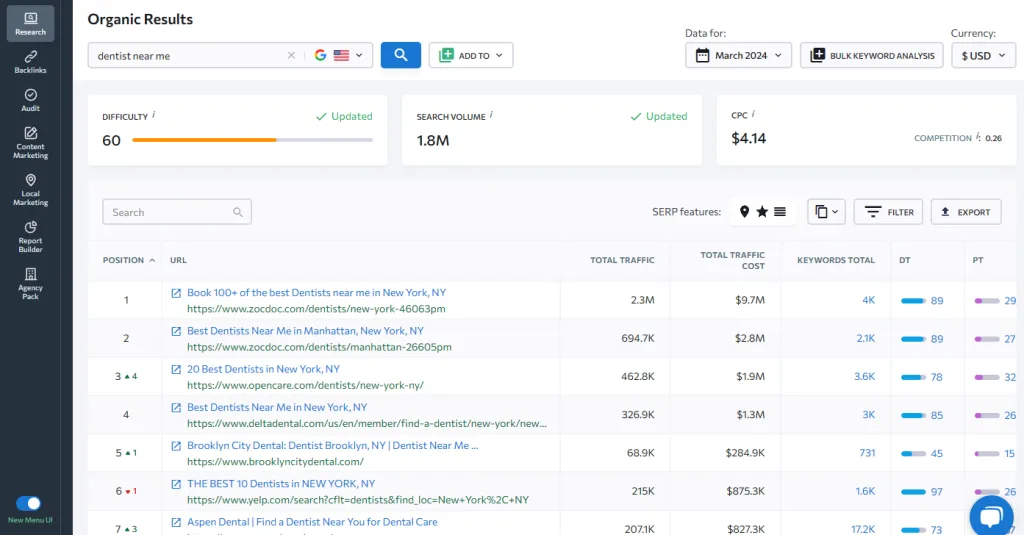
This is done by analyzing key factors such as page authority, domain trust, content relevance, and the presence of SERP features like featured snippets, local packs, and knowledge panels.
This insight allows you to understand the dynamics of current top performers and to pinpoint opportunities where your content can outperform or fill gaps left by others.
Strategies for Competing in Crowded SERPs
Competing in crowded SERPs demands a multi-faceted approach. Use the insights from SERP analysis to:
- Create Superior Content: Develop content that addresses user intent more effectively than your competitors. This might mean offering more depth, better visuals, or a unique perspective on the topic.
- Optimize for User Experience: Ensure your site offers an exceptional user experience, with fast loading times, mobile optimization, and intuitive navigation.
- Leverage SERP Features: Identify opportunities to capture featured snippets, FAQ sections, or other SERP features that can increase your visibility.
- Build a Strong Backlink Profile: Focus on acquiring high-quality backlinks to increase your site's authority and trustworthiness.
- Utilize Schema Markup: Implement schema markup to enhance your content's appearance in SERPs, making it more attractive and informative to potential visitors.
By applying these strategies, you can differentiate your site and improve your chances of ranking well, even in competitive niches. Continuous monitoring and adapting your approach based on SERP changes and competitor movements are key to maintaining and enhancing your position.
10. Grouping and Organizing Keywords for Targeted Campaigns
The Importance of Keyword Clustering
Keyword clustering, the process of grouping related keywords, plays a pivotal role in refining SEO and enhancing user experience.
By organizing keywords into clusters, you create a foundation for targeted content campaigns that speak directly to specific audience segments. This approach not only boosts your SEO by aligning closely with search intent but also ensures your content remains relevant and engaging.
Effective keyword clustering leads to a more organized content strategy, allowing for the development of comprehensive pages that address multiple related queries at once, thus improving your site's authority and relevance in your niche.
Keyword Grouping with SE Ranking
SE Ranking offers a useful tool for keyword grouping, facilitating the organization of your keywords into buckets or clusters based on their SERP result similarity.
By inputting your keyword list into SE Ranking’s Keyword Grouper, the tool automatically suggests groupings based on semantic similarity and search intent:
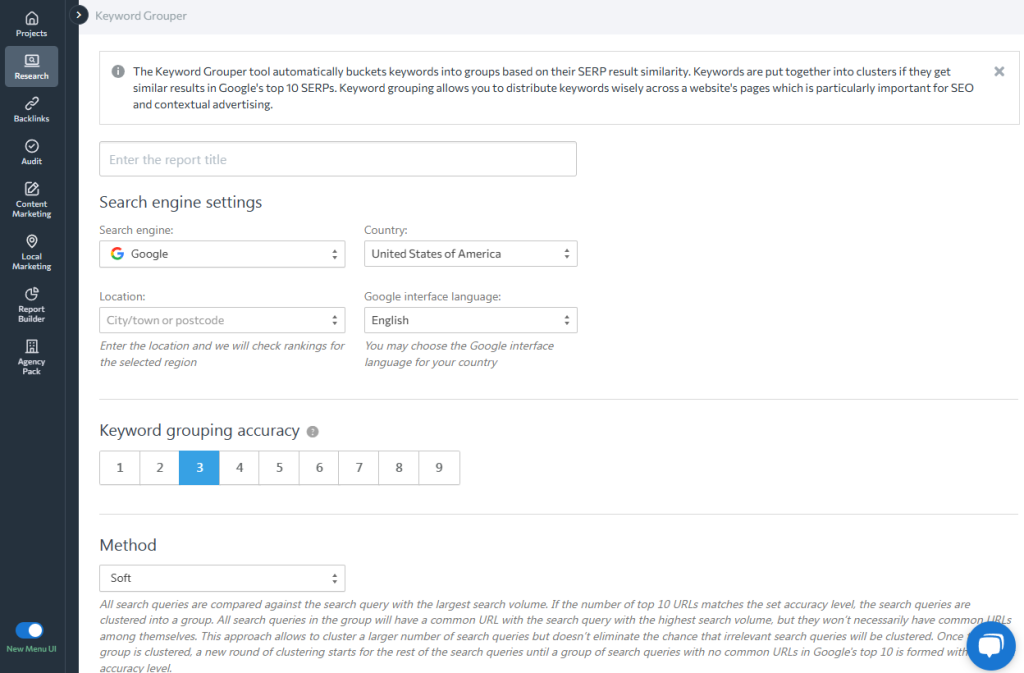
This helps streamline your keyword organization process, ensuring that each cluster is tightly focused around topics that matter most to your audience.
With this tool, you can quickly identify opportunities for content creation that targets multiple related keywords, maximizing your SEO efforts across your entire site.
Implementing Keyword Groups in Content Strategy
Incorporating keyword groups into your content strategy requires a thoughtful approach to ensure your site's content architecture supports and enhances your SEO goals.
Here are some tips for effectively using keyword clusters:
- Develop Pillar Pages: Create comprehensive pillar pages that serve as the cornerstone for each keyword cluster, addressing the main topic in depth and linking out to more detailed pages on related subtopics.
- Tailor Content to Clusters: For each cluster, produce content that specifically targets the group's intent and variations, ensuring coverage of all aspects of the topic.
- Interlinking for Context: Use internal linking to connect related content within the same cluster, helping search engines and users navigate your site more effectively and understand the relationship between different pieces of content.
- Monitor and Adjust: Regularly review the performance of your keyword clusters and the corresponding content. Use analytics to identify which clusters are driving traffic and conversions, and adjust your strategy to focus on the most effective groups.
By grouping and organizing keywords for targeted campaigns, and integrating these clusters into your content strategy, you can enhance your site's SEO performance and provide a richer, more engaging experience for your visitors.
Final Thoughts
Mastering diverse keyword research techniques is essential for sculpting a successful SEO strategy.
From identifying seed keywords to leveraging the nuances of keyword intent and competition, each technique offers unique insights that, when combined, can dramatically enhance your online visibility and engagement.
SE Ranking stands out as a powerful ally in this journey, providing an all-encompassing toolkit for efficient, data-driven keyword research and strategy development.
The right SEO software features enable you to navigate the complexities of SEO with precision, ensuring your content resonates with your target audience and your website achieves its full potential in search rankings.